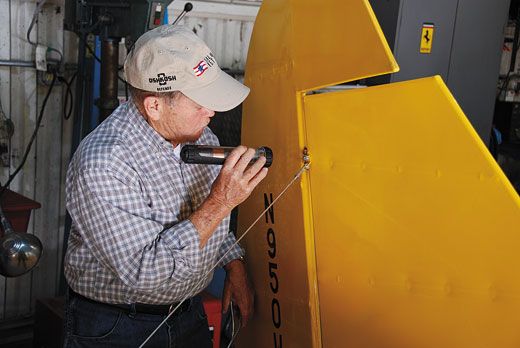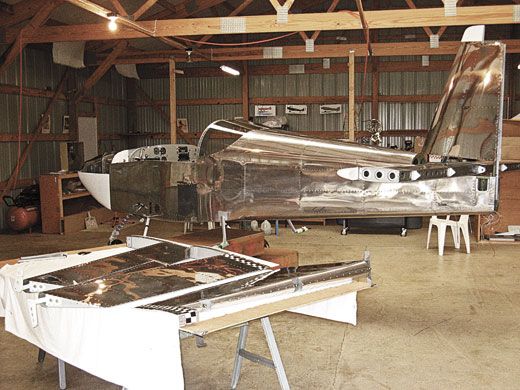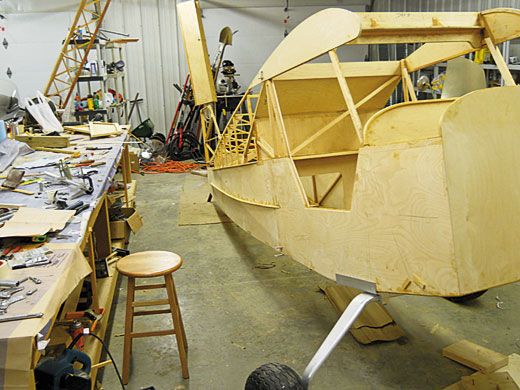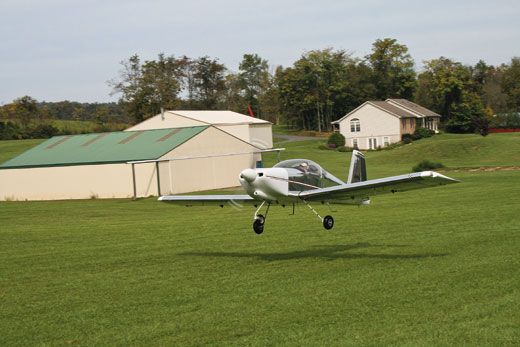Pilots Spend A Great Deal of Time Building An Airplane in Hopes of Receiving a Pink Certificate
Inventive design or fatal flaw? On a homebuilt airplane, one person makes the call.
/https://tf-cmsv2-smithsonianmag-media.s3.amazonaws.com/filer/Judgement-flash-631.jpg)
Ed Schupp’s newly completed Van’s RV-9A kitplane sat center-hangar at the Hedgesville, West Virginia airpark, stripped down for a thorough inspection: Cowling, panels, and plastic fairings had been removed, exposing the levers, pulleys, and other mechanical magic that make an airplane slave to the pilot’s command. James R. (Bobby) Thomas was on his way there to make sure this bird would fly.
As a designated airworthiness representative (DAR) for amateur-built aircraft, Thomas, 76, is authorized by the Federal Aviation Administration to certify the airworthiness of what are commonly referred to as homebuilt aircraft—the metal, tube-and-fabric, or composite creations that take shape in basements and garages throughout the nation. Pilots work weeks, years, or sometimes decades to make an airplane they can take off and fly in, their lives invested in every rivet. When the builder is done, he calls in an expert to inspect the aircraft; if it passes, the builder is awarded a small pink certificate declaring that the aircraft is safe and legal. When Schupp was done, he called Thomas.
More than 30,000 U.S.-registered aircraft are classified as “experimental amateur-built.” The category, which allows amateurs to construct an airplane “for educational or recreational purposes,” helps lessen the sting of rising aircraft prices—a kitplane can cost a fraction of a production airplane—and frees designers and builders to experiment with unusual designs.
Building and flying one’s own aircraft is only for a certain kind of pilot. Thomas estimates that out of each of the 1,000 or so chapters of the Experimental Aircraft Association, an organization founded to support amateur airplane builders, about 10 percent of the members are “doers”—people who go beyond dreaming to buy some sheet metal and start riveting. Of those, he estimates, 30 percent finish their project. And of the finishers, several dozen have gone on to become eligible to issue airworthiness certificates to their fellow builders.
Thomas had retired from a banking career in which he financed aircraft, and in 2004, having built four airplanes, he became a DAR. The FAA had created a DAR qualification specifically for amateur-built aircraft in 2002; Thomas was one of the first to qualify in that category. “The aviation community gave me a life,” he says; now he’s giving back, by keeping people from killing themselves.
Designees like Thomas perform functions similar to those of FAA staff inspectors and report to agency supervisors; they allow the agency to cover more ground with fewer full-time employees.
The FAA taps into the collective wisdom of a community—“airport bums” who have spent enough time machining or rib-stitching to know where another builder is likely to go wrong, and to distinguish between a strange design decision and a potentially fatal flaw. Inspectors who qualify from their homebuilding experience must have built an aircraft that has flown for at least 100 hours and have experience conducting routine inspections on amateur-built aircraft. They must be certified airframe-and-powerplant mechanics, though not necessarily by vocation. From a director of flight operations to a retired professional banjo player, they come to the position from all walks of life. By late 2011, 251 DARs were authorized to give airworthiness certificates to amateur-built aircraft; former EAA Government Relations Director Randy Hansen estimates that about a fifth qualified from their homebuilding experience, mostly through their affiliation with EAA. (Those sponsored by EAA are reimbursed for expenses by the builder but volunteer their time for the inspection; others may charge the builder from $300 to $1,500, Hansen says.)
Like many of his fellow DARs, Thomas earned his bona fides as much from practical experience as from formal schooling. He started building his first airplane in 1970, he says—a single-seat, metal Parker Teenie Two with an empty weight of a little more than 300 pounds. You could build it out of truck body aluminum, using a Volkswagen engine and Coca-Cola hand truck wheels, he adds. By the time he enrolled in A&P classes at Frederick Community College in Maryland, he had already built the Teenie and a Sonerai racer, and had started on a Wittman Tailwind. He learned the trade largely by helping his friend and mentor Richard Roberts rebuild and re-engine aircraft.
Hang out at airports until someone puts you to work: It’s a strategy as old as aviation itself. Jon Ross, a DAR based in Long Island, New York, says he earned his A&P license in the “school of hard knocks.” While working as a flight instructor, he spent the time he wasn’t teaching at the shop. “I got it by having mentors, people who leaned over my shoulder,” he says.
As he drove the familiar, winding roads to the West Virginia field where Ed Schupp’s airplane waited, Thomas recalled Roberts and others who have populated his life in aviation. The ones who lived and died by aviation—like Roberts, who died in a crash at the National Championship Air Races in Reno in 1998—remind him during each inspection that he’s not there to make someone happy; he’s there to keep someone safe.
He stepped out of his tan Ford Focus station wagon with a stack of paperwork, a flashlight, and reading glasses. Schupp chatted with a friend near the shiny, single-engine airplane. Through a leaky roof, rainwater dripped slowly near the airplane’s left wing.
Thomas is qualified to inspect experimental amateur-built airplanes, as well as both kitbuilt and factory-built light sport aircraft; he has done the initial airworthiness inspection for about 170 airplanes. About 45 of them have been light sport, he says, including a tube-and-fabric Sky Ranger that Schupp built in 2003. Schupp’s work had been meticulous then, but a DAR takes nothing for granted.
When forgetting a two-cent cotter pin can bring down a $70,000 airplane, neither builder nor inspector can afford to make assumptions. On Halloween 2006, a Jahns RV-7, a type similar to Schupp’s, took off from Monmouth Executive Airport in New Jersey on its first flight, the DAR at the controls. The airplane performed a series of steep turns without incident and made a pass over the runway before the throttle linkage came loose. The pilot could not accelerate. The builder watched as the airplane turned back to land, slowed, and entered a stall. The nose dropped to the ground. The landing gear crumpled. The airplane came to a halt so quickly the rudder was kinked. But the test pilot stepped out unscathed.
The DAR (whose name is not given in the accident report) had checked on the project prior to the inspection, he explained, and had told the builder during his last visit to fix a part of the throttle linkage. When he arrived in his role as DAR, the lower cowling covered the linkage. Because he considered its removal “disassembly,” not allowed if a builder provided records of in-process inspections, he left the cover in place. If he had removed it, he would have seen that the builder had forgotten either to insert or to bend the inch-long pin securing the nut. When it came loose, nearly seven years of work slammed into the ground.
Schupp purchased his first kit for the RV-9A on May 20, 2004. He didn’t build the aircraft all in one stretch, but he built it: Photographs documented the process, from the arrival of boxes to Schupp wielding a rivet gun. The images would help convince Thomas that Schupp completed the majority of the work himself—a requirement known as the 51 percent rule. As long as the builder completes the major portion of the work, he can enlist help. But if more than 49 percent of the labor is farmed out—for instance, to a company that sells airplane kits—the builder cannot qualify for an experimental airworthiness certificate, which is reserved, in the FAA’s language, for “persons who undertook the construction project solely for their own education or recreation.” Ross, who finished an RV-8 in 2004, says he employs legendary kitplane designer Burt Rutan’s “seven-minute rule.” “If anyone comes in and they want to chat, I’ll spend seven minutes with them and then put them to work,” Ross says.
Many builders solicit help more formally from volunteer builders, restorers, and mechanics in EAA’s technical counselor program. DARs with homebuilding experience usually also are technical counselors. Some, like Joe Gauthier of Connecticut, swear by the program. If a project is within a 50-mile radius, he wants to see it as a technical counselor before he inspects it as a DAR. It gives him a chance to provide guidance early in a way he can’t as a DAR and gives the builder a sense of what he’ll be looking for. “By the time I get there with my DAR hat on, most of the issues are resolved,” he says.
Thomas is also a technical counselor, but when he’s counseling he doesn’t volunteer that he’s a DAR: He doesn’t want builders to be nervous about the final inspection when he’s trying to help them, he says. Proudly five-foot-four, he’s not physically intimidating, and he likes it that way: He’s Bobby, not James or Robert.
Builders are often smiling when the DAR arrives, and Schupp had reason to be confident: Members of his EAA chapter had looked over his RV many times, he says, and a technical counselor had visited after each major stage of construction: empennage, wings, fuselage, and engine. He even ran through his own inspection checklist, examining the airplane from spinner to tail, he says. But there’s always a chance the DAR could catch something the builder missed.
“Any time you have someone looking over your work…you get very protective of it,” Schupp says. But he was counting on Thomas’ fresh eyes to keep him safe when he taxied out to the runway and opened the throttle.
Thomas laid a folder of FAA forms and checklists, all in duplicate, on the table. Meticulous record-keeping helps the DAR protect himself in the event of an accident. “The wing could fall off the airplane, but if it didn’t have a builder’s log, that’s the problem,” Thomas later quipped as he photographed Schupp’s builder’s log. He fanned out photographs of the various stages of construction and took another picture for extra proof.
The FAA provides a list of minimum requirements for an inspection, but each DAR has an area of special concern. Thomas’ is fuel flow. He won’t even look at an airplane until he has the flow data. (He’s not alone in his attention to the fuel system: Frank Sperandeo, an Arkansas-based DAR, says he makes his clients flush the system five times before he inspects it.)
Lying on his back on the concrete, New Balance sneakers jutting out from under the fuselage, Thomas checked the throttle linkage as Schupp opened and closed the throttle from the cockpit. Mixture, throttle, carburetor were all in working order, but Thomas suggested Schupp add a transmission screen to keep insects from crawling in. “Bugs have put more than a few people in the ground,” he says. If spiders crawl in and keep gas from making it to the engine, you’ll have just enough in the fuel lines to get 150 feet off the ground, he says—too high to have much runway left, too low to turn back.
The screen is just a suggestion; a DAR won’t deny an airworthiness certificate just because he would have done something differently. Gauthier explains to builders that three types of issues might come up during an inspection. First, the showstoppers: cotter pins or safety wire missing, bolts that are too short or too long. The builder must fix these before the DAR can put the pink certificate in his hands. Second, items that don’t conform with design: a fuel valve in a different place, a change to the instrument panel. In those cases, the builder and the inspector discuss the non-conforming item, and the builder must justify his decision. And finally, deviations from best practices: A builder deviating that way can get a certificate, but may also have to justify his decision. “We know from many years of flying that if you bury even the most innocent device where you have to reach awkwardly to reach it…it’s not a good idea,” Gauthier says.
The National Transportation Safety Board determined that a placement like that played a role in the 1997 accident that killed singer John Denver. The builder of Denver’s newly purchased Long-EZ had modified the fuel system from the plans, locating the selector behind and above the pilot’s left shoulder. Investigators found that one would naturally push the right rudder pedal when twisting left, consistent with witnesses’ reports of the airplane’s behavior before it plunged into the ocean near Pacific Grove, California. While investigators cited aspects of the builder’s nonstandard fuel system as factors in the crash, they attributed it primarily to Denver’s own actions. Unusual design decisions might not do you any favors, but they generally don’t kill you on their own.
Thomas will point out the potential hazard of nontraditional choices, but he values a builder’s freedom to make that choice. In a general aviation market dominated by a few, decades-old designs, the amateur-built category provides a venue for creativity. “We’ve gotten better airplanes because of it,” Thomas says, "but it has wasted a few lives.”
Schupp’s aircraft was by the book. For his first metal airplane, he had chosen a design from Van’s Aircraft’s line of easy-to-assemble RVs (they’re pervasive in the world of homebuilding—Thomas still flies his RV-4), and saw no need to stray from Van’s proven formula. Thomas felt the connection where the wing met the fuselage, then slid his camera into an inspection panel in the wing.
Airframe failures are less common than engine trouble. Inspecting the inner workings of the elevator—the tail section controlling the aircraft’s pitch—Thomas explains that he once found a bolt there with no nut. Unchecked, it could have wiggled loose, and the pilot could have lost control of the aircraft. Of all his inspections, Thomas says proudly, not one has crashed because of an airframe failure.
Six weeks later, Thomas learned that an aircraft he had inspected was involved in a fatal accident. On October 5, 2011, Harry L. Weber, a retired airline pilot, took off from the turf runway at Hedgesville, West Virginia, two days after the first flight on his Arion Lightning, an experimental light sport aircraft. Witnesses say the Lightning pitched up to a 45- or 60-degree attitude—too steep, it seemed, to generate the lift needed to keep the airplane aloft—and dropped to the ground, hitting a house and killing the pilot.
Months later, the crash still weighed on Thomas’ mind. “That’s the first one I lost in nearly eight years of doing it,” he explained at an inspection at Baltimore, Maryland’s Martin State Airport. Amid the bustle of the spacious maintenance hangar, he paused, lips drawn tight. “But I don’t know what I could have done.” The NTSB’s preliminary report on the accident cited no evidence of a mechanical problem, and Thomas doesn’t think the final determination will either. (As of press time, the final report was not in.)
Airmanship is as serious a concern as mechanical soundness. Of the test-flight accidents that occurred from 2005 to 2010, the NTSB attributed almost as many to the pilot’s actions as to a problem with the airplane; of the fatal accidents, only one was attributed to a mechanical problem. Pilots who spend their free time in a workshop spend less of it in the air, and even high-time pilots are more prone to fatal mistakes in unfamiliar aircraft. The FAA attempted to address this issue in early 2011 with new guidance for pilots transitioning to amateur-built or unfamiliar aircraft. The agency formulated the advisory circular, AC 90-109, in conjunction with the EAA, the Aircraft Owners and Pilots Association, the National Association of Flight Instructors, and the Lancair Owners and Builders Organization. The FAA says its goal “is to reduce the GA [general aviation] fatal accident rate per 100,000 flight hours by 10 percent by 2018.”
As Thomas finished inspecting the aircraft, Schupp used a Phillips-head screwdriver to reaffix the inspection panels and cover the joints between wing and fuselage: He used no power tools for the whole project, he says, and wasn’t going to start now. Joining the top and bottom cowling took some wrangling, but by early afternoon Thomas was checking off boxes on the conformity inspection record. Next to “Overall Workmanship,” he put an “X” by “Outstanding.” When all the boxes in all the checklists were filled, he issued the airworthiness certificate.
Before he left, Thomas watched Schupp taxi to the runway and back in his newly airworthy airplane. But it would be almost two months before the RV-9A set out on its first flight. Schupp had planned to have a test pilot fly it a week later, but became absorbed in the finishing touches—interior work, painting the trim. When it did fly, he says, it was perfect.
Sarah Brown is a Web editor for the Aircraft Owners and Pilots Association.



